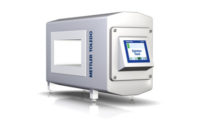
Proper training and education on metal detectors is a key to proper installation. A topic that creates countless hours of training and numerous service calls is product rejection. False rejects, false positives, constant rejecting and kickouts are all terms used in describing metal detectors reacting to a change.
There are two types of reactions: the first causes product to be ejected from the production line. The most common reason for this type of reaction is because there is metal contamination found in the product. Companies that are new to metal detection are often amazed when a detector finds metal in their product. In fact, some don't even believe it is possible that they have a contamination issue. The second type of reaction occurs when the detector reacts without anything going through it. Often referred to as a false reject, this can create a loss of confidence in the metal detector.
Prior to purchasing a metal detection system, proper research and product testing is the first way to reduce false rejects. When creating a metal detection system for a company, typically the vendor requests that product is sent to be to be tested. Product factors like product temperature, line speed, core temperature for frozen food and product alignment on the conveyor, must be considered in a proper test. This test provides a solution for the customer; creating detection sensitivities, metal specifications and a specific metal detection system.
The vendor should offer a test lab specifically for this purpose operated by a product test specialists using multiple detectors of various sizes and frequencies.
It is always advisable for customers that request product testing, to review the results from all vendors and look for consistency in the sensitivities. Detectors can be set to meet a particular specification, however if they run for long periods of time in a production environment they might cause false rejects or erratic operation. A reputable vendor will always provide the customer with a detailed "Sensitivity Statement" that guarantees the sensitivity of the detector. In some cases, the statement will clearly state that their specifications are beyond the limits of the metal detector.
Long periods without false rejects are the key distinguishing factor of a top quality metal detector. Improper installations can cause false rejects. In some cases, a quality metal detector can be mounted on a conveyor that is not designed for metal detection. This will create false rejects as a common problem. An incorrectly designed conveyor structure, reject device or even an improperly installed unit can cause interference signals from ground loops. A modification, like the addition of a belt scraper, if it is not properly isolated, can cause false rejects. These problems typically result in service visits and eventually the problem is resolved, but not after service costs and lost production time. Education and training will eliminate these service costs and lost production time.
False rejects can also be caused by influences beyond the metal detection system. Hand held radios and cell phones are typical sources of interference. Other interference sources are variable frequency drives, however they will make the detector act erratic vs. a random false reject. Quality equipment will address these interference issues with specialized frequency filters. A common source of false detection is static discharge, found in gravity feed systems, pipe lines and conveyors. Static discharge is not typically random but more of a timed trigger. By integrating a conductive plastic to dissipate the static, manufacturers of metal detection equipment can eliminate this problem.
The last area that can cause false rejects is conveyor belt contamination. The conveyor belt can be contaminated from weld slag, small pieces of wire, or even used grease. Precautions should be taken when working around metal detection systems to prevent belt contamination.
It is important to remember that simply having a metal detector on a production line, while providing a measure of protection, will never replace an all-inclusive contamination detection plan. Proper procedures and training must be integrated into the everyday production cycle to insure a contaminant free workplace.





